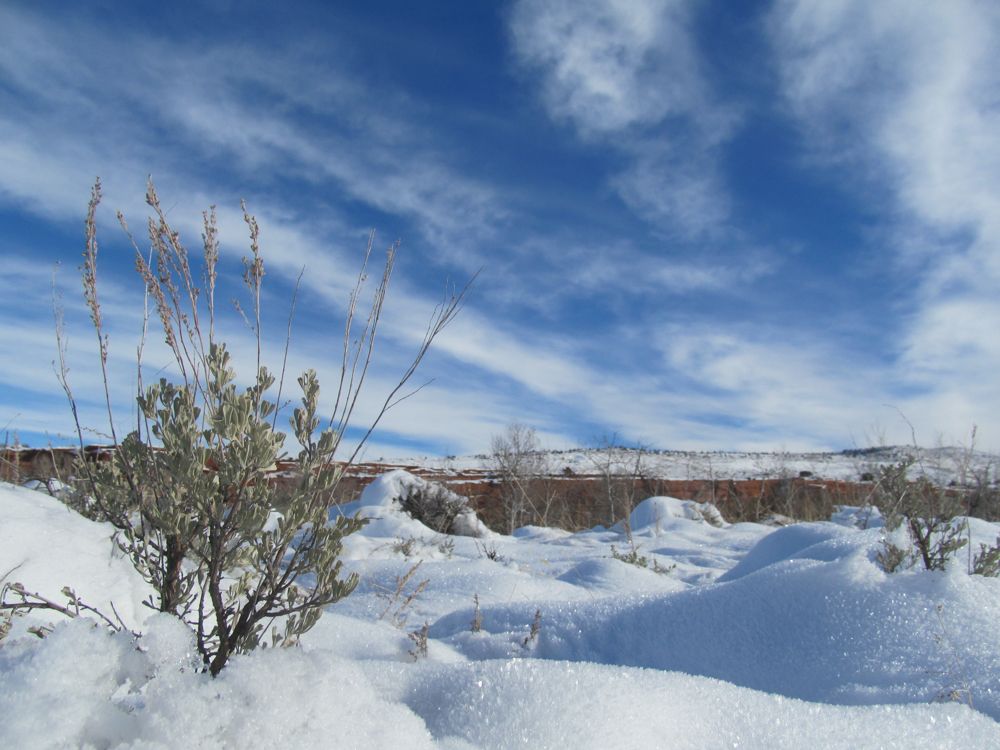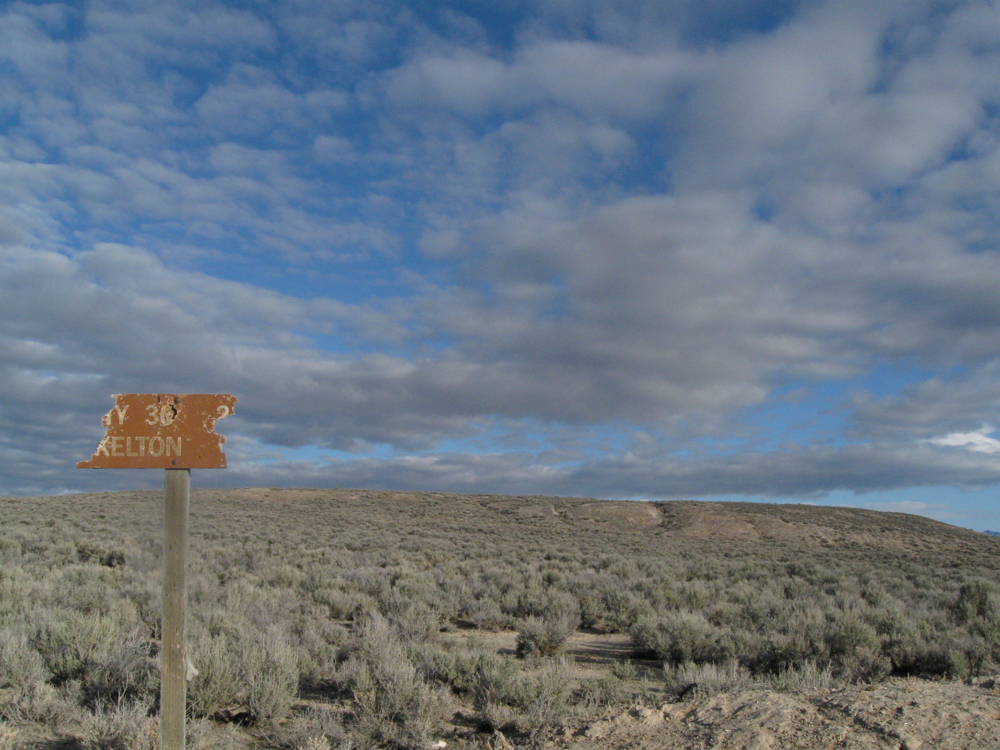Thick, pungent smoke billowed from between the two pieces of wood. First, wispy and upward in strung out curls, then heavy, grey, and everywhere. The lungs, laboring from the arms’ work, inhale its rough, acrid texture, coughing, wanting it out even as it brought joy, light, and life.
My first interactions with big sage (Artemisia tridentata) were functional. Simply put, the longer, dryer, and straighter, the better the spindle; the wider and dryer, the better the fireboard. We collected it from a wash somewhere near Sandy Creek. The creek’s sage, tamarisk, and willow laced banks cut a cow infested swath of brown, thick water through the barren, stark clays and sand of the Southcentral Utah, Henry Mountain desert. Head high, we would use a small folding saw to cut a wrist thick piece, then peel and shape it. My tool of choice for the peeling and shaping was a red Victornox, locking blade knife, long since donated to the desert at a now forgotten time and place. We would string the cigar shaped spindle into a long wooden bow, wrapping the bow’s string once, or twice, around the spindle. With one knee on the granular red dirt and the other foot planted on the fireboard to hold it in place, we would fumble to fit some sort of rock onto the sharp spindle top before attempting to move the bow back and forth while pushing down on the rock. It was all kinda convoluted, but we did it anyway.
Sage’s smoke too, was functional. Years earlier it was the mugwort variety (Artemisia ludoviciana) that Bob and Lisa used, then Peter and Kevin, as smudges to purify before sweat lodges and ceremonies. Then in 2000, in the Utah desert, beneath the crumbly, ochre slopes of Steele Butte and on the sprawling juniper-pinyon covered benches on the west side of the Henry Mountains, Josh and Chris did the same; wrapped tightly together with a natural-ish twine, they passed the smoldering bundle in front of us, guiding us to take the smoke in our hands and spread it over our still fresh bodies.

Indeed, all indigenous peoples who have inhabited or traveled through these vast tracts of sage made, and still make use of it. The camphor in its leaves is used medicinally for coughs, colds, headaches, stomach aches, fevers, and to relieve pain during child birthing; its bark can be used for candle wicks and the weaving of sacks; its flowers and leaves to create golden dyes (1a). Cultural appropriation, or maybe “misappropriation,” is not a phrase that meant anything to me at that point in my life. Now, I see with more understanding that acts of taking specific parts of a culture (a smudge ceremony, for example) that are befitting or appealing and not having to live with the impacts of being termed savages or having a recent history in which the approriating culture sought to systematically eradicate and erase you and your culture as something that is inherently problematic. Privilege wasn’t part of my vocabulary as thick as it was in my identity.
Sagebrush grows in expansive tracts and its ecosystems have the largest habitat range in the United States, covering nearly four hundred and seventy thousand square miles across eleven western states (1). The sagebrush that covers this landscape isn’t the sage you might buy or see in the supermarket’s spice section; common names of plants often confuse the real relationships among plant families. In this case supermarket sage, or Salvia officinalis, is an herb used as a spice and for its medicinal properties, and it’s a member of the mint family Lamiaceae, along with chia and rosemary, all of which have long, historical uses in culinary, medicinal, and religious applications. More than one culinarily creative student of mine has come to me wondering about the bitter, inedible nature of their otherwise well crafted meal. The sagebrush that that I write about here, the one that casts short, stubby shadows with dried, twisty, gray branches on bright orange paintbrush blooms, (Artemisia tridentata), is in another botanical family altogether—the sunflower family (Asteraceae). Botanical families sometimes, on the surface level, make for strange relations, much like sage and sunflowers (2). There are somewhere in the neighborhood of 470 species in the Artemisia genus (3) and there are, like its cousin in name, notable historical uses of the Artemisia plants, in addition to what is noted above. The genus contains plants known as wormwoods, from which vermouth and absinthe are sourced, and in the Bible, wormwood is cast down in the Book of Revelations (8:11) to make our planet’s water bitter and undrinkable. Additionally, Artemisia annua, for millenia, has played a crucial role in malaria treatments (4) though now artemisinin derivatives fill the role of the plant itself (5). In Hellenistic culture, which spans the about the 300 years BCE in the Mediterranean region, Artemis was a goddess of the hunt, and protector of the forest and children (6).
Despite what I write here, sage isn’t really a desert plant; it is a plant of the steppe. And regardless of the numerous cattle that inhabit the intermountain west, the slightly toxic shrub isn’t good forage for livestock, which has frequently led to widespread destruction in trying to cultivate a more hospitable forage for bovines.
After graduating college the desert called to me in the name of dependable and lucrative work in the Wilderness Therapy business. I was a snow and ice person though. I was not a desert person, or so I thought. I guess I had never experienced sage brush country or the desert with any intimacy and time before. Alaska, Wyoming, Washington, British Columbia: those places had high, glaciated peaks. This sojourn into the desert was to be a casual stop in a one horse town for a job that paid well enough and only required a six month commitment. I would be gone with the wind before the summer came around again. Yet I hadn’t counted on the sage and its propensity to grow in the in-betweens and wide open spaces however. I hadn’t counted on the sage’s taproot snaking its way into my being. I hadn’t counted on the desert as a place of healing.
After that, I wandered the Southern Utah desert professionally for seven years. Early on I told myself it was the money and work that dragged me back even as I tried to escape to higher altitudes and colder granite and ice. It is clear to see now that it was the landscape, that kept me returning. It was a dry, barren mistress that gave me the freedom I needed and wanted and let me show up when I needed. It is clear that the desert healed me. It took wounded and scared Jared and nursed him back to health, well that and seven years of wilderness therapy, even if the therapy was ostensibly for my students. Even after that fateful day at Blind Trail when i could no longer hold the students accountable, I returned. Even after I moved to Wyoming and vacated a long held storage unit in Loa, I returned. I returned in many forms, but mostly as a climber, guidebook writer, and denizen of the sage and its open country. I returned because it felt like home, because it made my heart sing, and the sand and red dirt ran through my veins.
My move from Utah to Wyoming did not leave me hungry for sage though. Moored to the foothills of the Wind Rivers, Lander floats in a calm harbor at the edge of an endless sage brush sea that stretches hundreds of miles into the Great American Desert of the Rocky Mountain west.

A decade later, when I purchased my house, there was never any doubt about what I wanted in my front yard. The beaten down grass was the perfect place to transplant some sage, rabbit brush, lupine, and globemallows.
Three Peaks Ranch, another outpost on the sagebrush sea allowed me access to adoptions. The boney, gravely soil couldn’t grow much, but sage thrived. Armed with buckets of horseshit dampened with water and a small spade, I searched for the right plants. Trial and error cost a few their hard won existence, my heart hurting with each that didn’t work. I learned to dig wide, to try to get some soil that would hang onto the expansive roots. Digging small ones allowed easier encompassing of all the roots. Usually though, it was the bigger ones that survived the two hour drive back to Lander.
What I didn’t know though, until deciding to write this piece about sage, is that sage plants are locally adapted. Local adaptation means that plants from a local habitat are genetically adapted to a place and will outperform/survive the “same” plant from distant areas. In my case, the transplants from Three Peak Ranch were coming from a higher elevation, 7,000 feet, and a drier, bonier, more gravelly soil; the front yard at 616 Washakie is much more compact and claylike and sits at roughly 5,300 feet. Researchers used a “common garden” to compare locally sourced sage plants/seeds to plants/seeds sourced from 12 distant locations and found that over the next two decades 100% of the local plants survived while 50-95% of non-local plants didn’t live (7).
I guess, for me with that information, time will tell. In the immediate, manure mixed into potting soil in the dense, nutrient poor dirt of 616 seemed to have impact, as did timed, regular watering. Over the next three years, my overall success rate reached 75 precent and I populated various parts of the yard with the small, round bushes, my smile growing greater as my goals got closer and closer. Despite evidence that points to long term disappointment, I guess I’ll keep adding them, though maybe I will try to dig them up just a little closer to home.
***
Throughout that fateful week in the autumn of 2000 we wandered hither and yon through various desert environs, but sage was the one constant whether on high dry benches, in lush riparian areas, or dotting rocky slopes. At night we lay down our tarp covered sleeping bags between the knee high giant, green, sugar coated gumdrops, we pried dead pieces from the dirt to feed our fires, wrapped its brittle, dry bark into nests to coax our hard earned embers to flame, and used the easily splintered, curled strands of wood to spoon thick beans and rice from metal cups to eager mouths. I was hungry; I was a hastily built, dry, crackle-y sage bark nest ready to ignite and sage was the ember that was thrust in, coaxed to fire, and brought me life, home, and place.
Featured Image: a close up of the silver haired, three lobed leaves of Artemisia tridentata, aka big sagebrush.
1a. https://www.desertusa.com/flowers/sagebrush.html#ixzz7FDhPFo4g
1. https://www.desertusa.com/flowers/sagebrush.html#ixzz7FDgse0jY
2. https://appliedeco.org/five-things-you-didnt-know-about-sagebrush/
3. https://powo.science.kew.org/taxon/urn:lsid:ipni.org:names:30001021-2
4. https://www.ncbi.nlm.nih.gov/pmc/articles/PMC7072484/
5. https://www.ncbi.nlm.nih.gov/pmc/articles/PMC163932/pdf/411413.pdf
6. https://en.wikipedia.org/wiki/Artemisia_absinthium
7. https://appliedeco.org/five-things-you-didnt-know-about-sagebrush/

Be First to Comment